Forums:
A few pix from our hike this past weekend... a "larch hike" up Pocaterra Ridge in Kananaskis Country:
Approaching the first band of larches, Larix lyallii:
Brilliant understory of acid-green/yellow bilberry leaves interspersed with dark crowberry; interestingly, the bilberry stems remain a darker green:
Larches in the distance and close-up:

There were not many flowers left but I did see this lone Penstemon confertus: 
There was a very heavy smoke haze all day that obscured the distant views, but the scenery was great nonetheless:





Comments
Lori S. (not verified)
Re: Fall larch hike - Alberta Rockies
Mon, 09/24/2012 - 8:14pmThis bright green lichen (Letharia sp.) made a stunning contrast with the black larch bark:
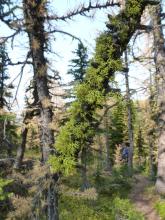
... and added another shock of colour to the tapestry of yellow and greens from the bilberry and crowberry on the forest floor:
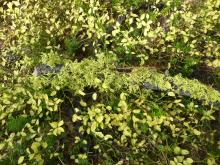
Still a couple of Sedum lanceolatum in bloom:
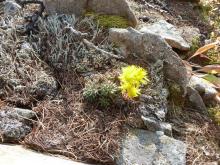
Down the valley:
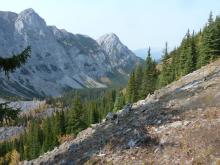
Asters:
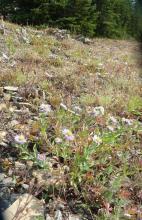
A group of three blue grouse (or whatever they are called now?) came out of the woods and wandered across in front of us, poking around for food and chasing grasshoppers... we stood still and watched them, and they got very close:
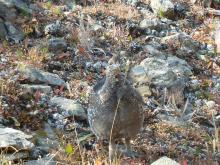
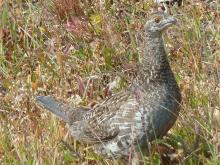
Lichen on the rocks; fall-coloured alpine potentillas and other plants among the rock slabs:
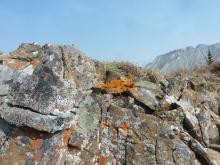
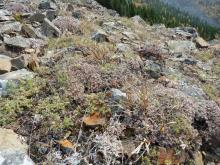
Up the valley with dry lakebed, and persistent snowbanks in the distance:
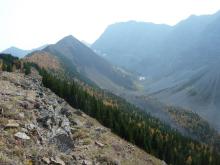
Lori S. (not verified)
Re: Fall larch hike - Alberta Rockies
Mon, 09/24/2012 - 8:30pmThe way up on these hikes tends to involve too much suffering to allow much botany appreciation ( ;)) but we were better able to take in the dense understory of false huckleberry, Menziesia ferruginea on the way down through the lodgepole pines:
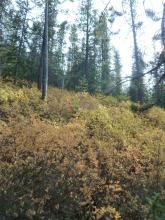
And wrapping up this account of an enjoyable hike, here are couple of photos of fungi and lichens...
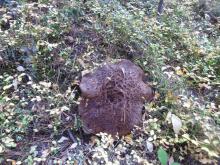
Edit: Sarcodon imbricatus(?):
Lichen, Edit: Cladonia deformis(?):
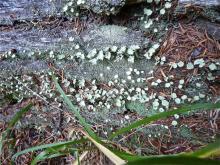
Trond Hoy
Re: Fall larch hike - Alberta Rockies
Tue, 09/25/2012 - 12:49pmVery enjoyable, Lori! A great tour.
The last fungus, could it be a Sarcodon imbricatus? Which is tasty as young!
The yellow? (you say green) lichen on that larch looks similar to Letharia vulpina (wolf lichen) used by farmers for poisoning wolves in old times.
cohan (not verified)
Re: Fall larch hike - Alberta Rockies
Thu, 09/27/2012 - 12:03amWe've had that smoke haze too, seemingly for weeks...
Great to see the Sedum :)
The alpine larches seem broader than our tamaracks, though it could just be younger trees? of course here, they don't often get to grow in a fully open place- at the least they have tall grass and willows, alders, birches around them, until they grow taller and often they also have spruce and many of their own kind to compete with...
Lori S. (not verified)
Re: Fall larch hike - Alberta Rockies
Sat, 09/29/2012 - 5:30pmYes, you may well be right about both IDs. Both the species you suggest occur here. For the lichen, it seems it would be either Letharia vulpina (has soredia) or Letharia columbiana (has large brown apothecia but never soredia); the former is the most common, while the latter is common at higher elevations especially on larch, subalpine fir and whitebark pine... now I have to try to figure out what that distinction means (something about the spore-producing structures, apparently). ???
Cohan, I haven't seen tamaracks in some time and can't even comment... was hoping we'd see some good black spruce bogs up north but it was much more deciduous upland than I expected.
Trond Hoy
Re: Fall larch hike - Alberta Rockies
Sat, 09/29/2012 - 11:27pmI am sure you have sorted it out by now, Lori!
Soredia and isidia are structures for vegetative propagation. A soredium produces powdery small "balls" consisting of an outer layer of fungal hyphae enveloping algae cells. An isidium is a small fingerlike structure which breaks off the lichen body. It too consist of fungal hyphae and algal (or cyanobacterial) cells.
An apothecium on the other hand is the spore-producing organ of the fungal partner in the lichen. It is often cup or bowl-formed with a contrasting colour. When the spores germinate they have to make contact with an appropriate algal cell.
cohan (not verified)
Re: Fall larch hike - Alberta Rockies
Sun, 09/30/2012 - 12:11amTrond, I need you to come and give me a primer on fungi and lichens etc! We have tons of non-vascular plants, and I love them and photograph them regularly, but I know little about them, and can id none! What little looking in books I've done only convinced me there are so many similar ones I have no hope of deciding a definite species!
Trond Hoy
Re: Fall larch hike - Alberta Rockies
Sun, 09/30/2012 - 1:25amCohan, it had been nice to visit you some time! However I am far from being an expert in lichen although I know a bit of the vocabulary ;D
Richard T. Rodich
Re: Fall larch hike - Alberta Rockies
Sun, 09/30/2012 - 9:20amI'm in the same boat as Cohan, and even that short educational post, Trond, was very interesting. I had no idea that there were lichen appendages with both algal and fungal components for dissemination. Thanks!
cohan (not verified)
Re: Fall larch hike - Alberta Rockies
Sun, 09/30/2012 - 11:53amYou're ahead of me, Trond ;D
Trond Hoy
Re: Fall larch hike - Alberta Rockies
Sun, 09/30/2012 - 2:08pmRick, you are welcome ;) I learnt about lichen, fungi and other things as a student a long time ago!